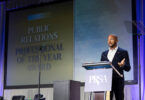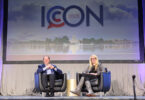Editor’s note: As we celebrate Ethics Month this September, PRSA invited members of the Board of Ethics & Professional Standards (BEPS) to provide their views and thoughts on the pressing ethical issues affecting the PR industry. Track the series and join the discussion by using the hashtag #PREthics. For a full list of Ethics Month activities visit the 2014 Ethics Month section of the PRSA site.
via: throgers
Public Relations Practitioners Well Equipped, But Often Absent in Employer Branding & Values Communication Efforts
When most people think about ethics, what frequently comes to mind is making decisions about what’s right and wrong and not so much about more proactive efforts. I believe public relations practitioners are especially qualified to make significant contributions in the areas of employer branding and values communication. However, this potential is often left unfulfilled.
In preparation for a new academic study on internal communications, I sought insights from authors in human resources and marketing and came across terms such as employer branding and employee engagement. Lloyd defined employer branding as the “sum of a company’s efforts to communicate to existing and prospective staff that it is a desirable place to work.” Employer branding tends to focus on experiential benefits such as education and training opportunities, advancement potential and culture, according to Moroko and Uncles. Among the foundations of organizational culture are core values.
Values are now viewed as both a competitive advantage and a means to increase employee loyalty. Through employer branding programs, companies and organizations are hoping to improve employee engagement, which Fleming & Asplund defined as “the ability to capture the heads, hearts, and souls of your employees to instill an intrinsic desire and passion for excellence.” Saks pointed out that engagement has been focused on motivating the “discretionary effort exhibited by employees,” or the willingness to go beyond the minimal efforts required to keep a job.
Last fall, I conducted 21 hours of interviews with 32 public relations and human resources practitioners working in 26 companies and organizations in 11 states in the United States and the District of Columbia.
What did I learn? Human resources executives tend to lead employer branding efforts during times of employee recruitment and orientation. Sometimes, but not always, public relations may assist in creating promotional materials such as brochures or videos.
Public relations practitioners played a dominant role in reinforcing values through finding employees living the company’s values and sharing those stories in company newsletters or videos. Examples of common core values found in the organizations that participated in the study included collaboration or “working without silos,” respect, honesty, integrity, innovation, workplace safety and customer service.
The best companies/organizations created awards programs that were tied directly to their core values or connected employees’ annual performance reviews to their values. But again, these efforts tended to be overseen by human resources.
So what does employer branding have to do with public relations? Public relations practitioners are experts in creating strategic communication plans and creating compelling content that employees want to read or hear.
In an earlier study I conducted, a corporate communications executive told me a story about how employees failed to respond to an email from human resources promoting a new wellness program. Then public relations stepped in and created messages that resonated with employees such as emphasizing why their health matters to their family members, and participation rates increased significantly. The difference? Public relations practitioners know how to create effective messaging that is engaging.
But this doesn’t mean public relations should only fulfill a tactical role in this realm. Sison has suggested that public relations practitioners should be involved in the planning phase, which refers to when values are first identified and refined. They can also make significant contributions in the areas of evaluating values communication through survey and qualitative research.
However, this responsibility is a collaborative one as public relations needs to partner with human resources and the executive team in these areas.
Why should we care? Employees are one of the most critical stakeholders for companies/organizations. As brand ambassadors, they bring core values to life through their interaction with customers and the public. Engagement is connected to key business outcomes such as profitability and customer satisfaction.
In contrast, previous research has found the costs associated with poor employee relations are estimated at $450 to $550 billion a year, includingabsenteeism, labor grievances, production interruptions, repair and warranty expenses, and employees who are disengaged or underperforming.
Finally, ethical employees are less likely to engage in behavior that could lead to a crisis. So values communication can be an issues management strategy.
Next steps: If you are not currently involved in employer branding and values communication, check with human resources to see what efforts may exist and how you can assist with communication efforts. If your employer does not have programs like these, conduct research to find out what other successful companies are doing. Some of the best models come from companies/organizations featured on Fortune’s list of best places to work, some of which were among the participants in my study.
*This study will be presented at the PRSA Educators Academy Conference in Washington, D.C. on Oct. 11, 2014.
Marlene Neill, Ph.D., APR is Assistant Professor, Baylor University, Department of Journalism, Public Relations & New Media
Resources for more information:
Fleming, J.H., & Asplund, J. (2007). Where employee engagement happens. The Gallup
Management Journal. Retrieved from: http://businessjournal.gallup.com/content/102496/where-employee-engagement-happens.aspx
Gallup (2013). State of the American workplace: Employee engagement insights for U.S.
business leaders. Retrieved from: http://www.gallup.com/strategicconsulting/163007/state-american-workplace.aspx
Gallup (2013). The state of the global workplace: A worldwide study of employee engagement
and wellbeing. Retrieved from: http://www.gallup.com/strategicconsulting/157196/state-global-workplace.aspx
Lloyd, S. (2002). Branding from the inside out. BRW, 24(10), 64-66.
Moroko, L., & Uncles, M. D. (2008). Characteristics of successful employer brands. Journal
Of Brand Management, 16(3), 160-175.
Saks, A.M. (2006). Antecedents and consequences of employee engagement.
Journal of Managerial Psychology, 21 (7), 600-619.
Sison, M.D. (2010). Recasting public relations roles: Agents of compliance, control or
conscience. Journal of Communication Management, 14 (4), 319-336.








[…] Neill, M. (2014, September 10). New Research: PR’s Role In Employer Branding. Retrieved January 27, 2015, from http://prsay.prsa.org/index.php/2014/09/10/new-research-prs-role-in-employer-branding/ […]